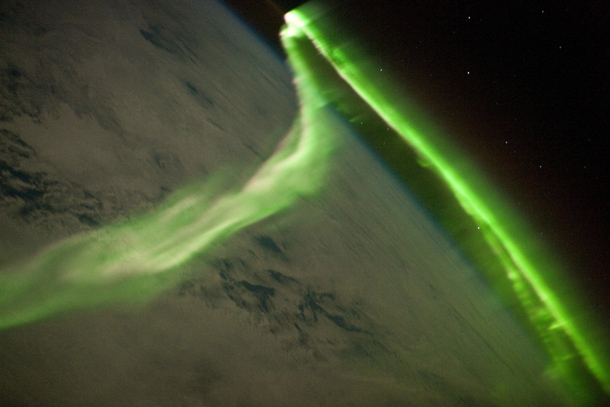Aurora Australis – Earth’s Green Ribbon
Hi everyone
Last week I uploaded some amazing images NASA took of the sun using their STEREO Ahead spacecraft. (See “Shooting Star” – Stereo Photography? blog posting).
Those “solar storms” are incredibly powerful, and yet the distance between the earth and sun (approximately 93,000,000 miles) is just right for life on earth. In fact, the solar storms have a really cool “side affect” that is truly spectacular. Once the stream of electrons and other charged particles reach earth they interact with gases in the atmosphere to generate colorful aurora.
When the charged particles from May’s solar storms reached Earth, they caused no damage, but they did generate sheets of colored light dancing across polar skies. This shot was taken by astronauts onboard the International Space Station.
Aurora Australis
Credit: ISS Expedition 23 Crew, ISAL, NASA
Taken on May 29, looking southward from about 350 km’s above the southern Indian Ocean
(The photograph was taken with a Nikon D3 digital camera).

It is hard to imagine the feeling of the astronauts as they watched this enormous, green ribbon shimmering below them. What a truly amazing moment to capture on camera!
As you may know, these “light shows” of ever-shifting colored bands are most visible near the North (aurora borealis or northern lights) and South (aurora australis or southern lights) Poles. Apparently though, severe storms impacting the Earth’s magnetic field can shift them towards the equator.
So how is the spectacular colour of an aurora produced?
The short answer:
Auroras happen when energy charged particles streaming from the Sun interact with Earth’s magnetic field.
The longer answer:
Auroras happen when energy charged particles (ions) from the sun (known as the solar wind) collide with atoms of oxygen and nitrogen in the upper atmosphere. The atoms are excited by these collisions, and they typically emit light as they return to their original energy level. The light creates the aurora that we see.
The most commonly observed color of aurora is green, caused by light emitted by excited oxygen atoms at wavelengths centered at 0.558 micrometers, or millionths of a meter. (Incidentally, visible light is reflected from healthy (green) plant leaves at approximately the same wavelength.) Red aurora are generated by light emitted at a longer wavelength (0.630 micrometers), and other colors such as blue and purple are also sometimes observed.
So there you have it. … As you might have guessed already, I find this stuff fascinating! I hope you did too. 🙂
Thankfully, light and how we see it will continue to stimulate our sight and the imagination. And of course, photography will continue to capture light in it’s various forms for our enjoyment.
Catch you next time.
Greg